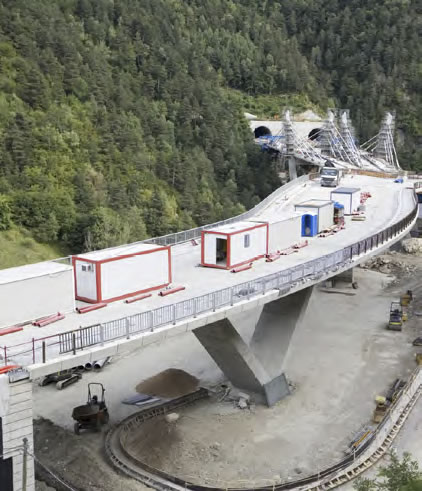The use of Public-Private Partnerships (P3s) marks a shift away from traditional ways of procuring and financing highway projects. Under traditional procurement processes, private contractors construct projects based on a public design using public funding. The projects are then operated and maintained by public agencies. With the P3 model, a private partner participates in a long-term contract involving some combination of design, construction, financing, operations, and maintenance, including collection of toll revenues.

After a P3 agreement is signed, the public agency must manage the contract to ensure that it achieves the performance standards established in the agreement. Performance monitoring and oversight will require building a strong set of skills within the public agency due to the need to maintain these oversight responsibilities in-house. This includes the need for contract management skills to monitor performance against the established performance standards and manage accordingly. The capacity to monitor technical performance during construction and operations can be critical to ensuring efficient service delivery.
Public-private partnership (P3) agreements establish long-term outcome-based performance specifications. Outcome-based performance specifications focus on what a facility is intended to achieve rather than prescribing means and methods for achieving facility goals. The purpose of using outcome-based performance specifications is to allow the concessionaire flexibility to decide how best to achieve the intended results, providing opportunities for innovation.
However, there is a natural tension between flexibility and accountability in performance management. If a standard is too flexible, the public sector risks not obtaining the highest possible level of performance from a concession. If a standard is inflexible, it may not adapt to changing technology needs. For example, in one P3 agreement for a tollway, a performance standard set for customer service was based on how quickly the concessionaire responded to phone queries. By the time the concession was active, most of the customer queries were received by email and through a website, which were not covered by the performance standards.
After the P3 agreement is signed, the public agency must manage the contract to ensure that it achieves the performance standards established in the agreement. Contract management responsibilities include:
Monitoring Technical and Financial Performance: Performance monitoring procedures can include self-reporting procedures, independent audits, regular meetings and reports, and the use of intelligent transportation systems that automate data collection and reporting processes.
Assessing Payments and Penalties for Performance: Penalties typically consist of payment reductions or retentions and non-compliance or default points. Once noncompliance or default points reach a specified level, they can result in increased oversight, performance of work by the owner at the contractor's expense, suspension of work, or termination of the contract.
Resolving Disputes: P3 contracts typically specify dispute resolution processes to reduce the risk of legal conflict over technical issues or differences in contract interpretation. Alternative dispute resolution processes may include mediation and third-party arbitration following a certain period of time if the parties are unable to resolve the dispute themselves.

Prior to mediation or arbitration, dispute resolution processes often define tiered systems of problem identification and resolution through negotiation to encourage resolution of problems at the lowest levels. For example, the contract may specify a process whereby the parties to a dispute are given a set time period to seek ways to resolve their dispute before it is elevated to their respective managers.
Managing Handback: P3 contracts generally specify the required condition of the facility at the end of the contract term. The condition of a facility at handback depends on the maintenance and operation procedures employed throughout the lifecycle of the facility, so the concessionaire is typically required to develop a capital replacement or asset management plan for equipment, systems, and assets. To manage the financial risks associated with handback, some P3 agreements require the concessionaire to establish a handback reserve account that begins to accrue toward the end of an agreement and may be used for unplanned repairs required prior to or shortly after handback of a facility to the public owner.
Public agencies can promote effective contract governance by facilitating knowledge sharing between the procurement team and the contract management team, by planning for skill and knowledge retention over the period of the contract, and by balancing the use of internal capacity and external advisors to ensure retention of that knowledge and skill within the agency.
Some public agencies have found that the best way for the contract management team to understand and manage contract provisions is for team members to have played a role in the development and negotiation of the contract. Public agencies can also improve the sustainability of effective contract governance practices by ensuring that decisions and processes are documented, and that succession planning takes place.
Mechanisms such as regularly scheduled face-to-face meetings can facilitate the development of an effective relationship between the government and the concessionaire. To maintain an effective relationship, enforcement mechanisms should be used consistently and proportionally.
The FHWA Center for Innovative Finance Support is a one-stop clearinghouse for expertise, guidance, research, decision tools, and publications on highway program delivery innovations. Our website, workshops, and myriad resources support transportation professionals in the use of innovative approaches for delivery of highway projects.
The FHWA Center for Innovative Finance Support's P3 program focuses on resources and capacity building for consideration and use of design-build-finance-operate-maintain (DBFOM) concessions funded through tolls or availability payments.
The FHWA Center for Innovative Finance Support's Alternative Project Delivery program provides information on contractual arrangements that allow for greater private participation in infrastructure development by transferring risk and responsibility from public project sponsors to private sector engineers, contractors and investors.
The FHWA Center for Innovative Finance Support's Project Finance program focuses on alternative financing, including State Infrastructure Banks (SIBs), Grant Anticipation Revenue Vehicles (GARVEEs), and Private Activity Bonds (PABs).
The FHWA Center for Innovative Finance Support's Federal Tolling and Pricing program focuses on the use of tolling and other road user charges as a revenue source to fund highway improvements, and the use of variably-priced tolls as a tool to manage congestion.
The FHWA Center for Innovative Finance Support's Value Capture program explores strategies for tapping into the added value that transportation improvements bring to nearby properties as a means to provide new funding for surface transportation improvements.